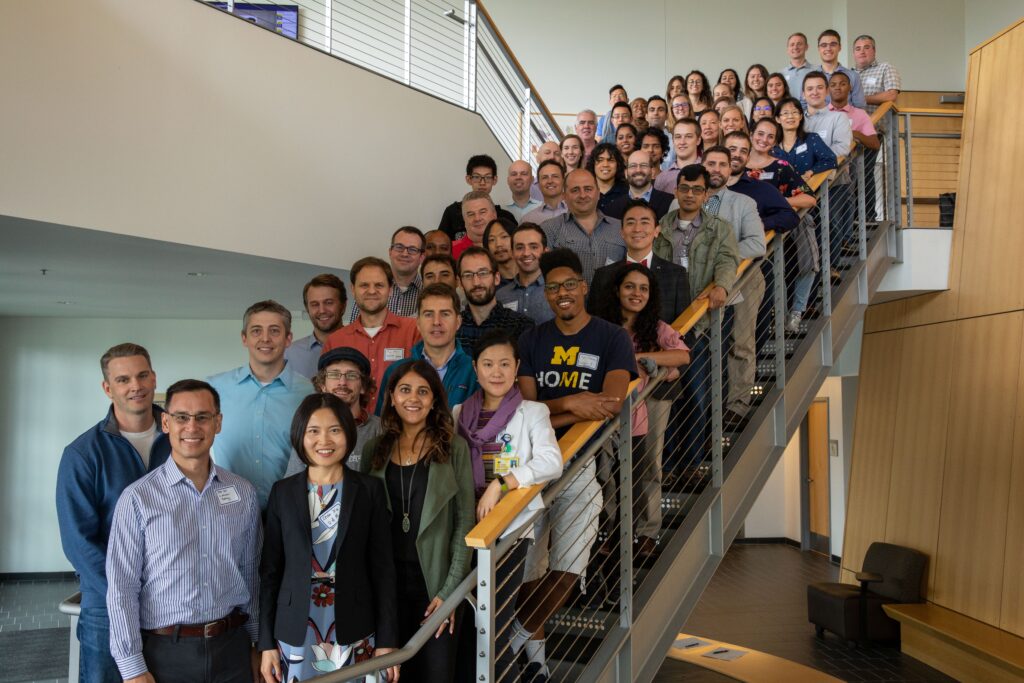

Photo (left): Histotripsy Summit held at the University of Michigan in September 2019. Photo (right): Representation of histotripsy bubble cloud destroying targeted liver tumors non-invasively and without heat or ionizing radiation (animation provided by Histosonics. Inc.)
Several members of the Department of Radiology, including Fred Lee, MD, Paul Laeseke, MD, PhD, and Timothy Ziemlewicz, MD, have been conducting pre-clinical research on histotripsy, a new non-invasive, non-thermal method to destroy tumors and other tissue, for more than 5 years. “Histotripsy is a novel technology based on external ultrasound that was invented at the University of Michigan. Our friends in Michigan were generous enough to lend us devices to use in our laboratory in human-size pigs, and since then, we have been working to make histotripsy a clinical reality,” explains Dr. Lee.
This work has been supported over the years by HistoSonics Inc. “The scientific work started at the University of Michigan, and still goes on there, but translating this work into large models simulating human use, developing the procedure, and refining the technology has happened to a great extent at Wisconsin,” says Josh King, Vice President of Marketing at HistoSonics. In addition to supporting the pre-clinical research behind the method, HistoSonics also sponsors ongoing clinical trials evaluating histotripsy safety and efficacy for patients with liver tumors.
The next step in the bench-to-bedside path for histotripsy is the new #HOPE4LIVER clinical trial. The trial is currently recruiting patients to treat primary and metastatic liver tumors using histotripsy with the goals of demonstrating the safety of the device and submitting it to the FDA for regulatory approval. The #HOPE4LIVER trial launched at the University of Wisconsin – Madison along with other sites, including University of Michigan, University of Minnesota, University of Kansas, University of Chicago, Medical College of Wisconsin, Tampa General Hospital, and Miami Cancer Institute, this month.
The first human trial for hepatic tumors took place in Barcelona, Spain in 2019. Dr. Ziemlewicz says, “From the trial, we learned a couple of things. We could successfully make these histotripsy treatments in the liver, and they were more accurate and predictable, more continually visible than our current treatments from microwave ablation. This means we could treat right to the edge of structures safely, patients felt little to no pain afterwards, and each patient was treated in a single session. Two out of the eight patients in the trial showed a response from their cancer outside the spot where the physicians treated, which is a rare occurrence in other ablation modalities and an exciting development of histotripsy.”
Dr. Ziemlewicz and former UW faculty and current UM surgeon, Clifford Cho, MD, serve as the Principal Investigators of the national trial. Lori Mankowski Gettle, MD, MBA and Meghan Lubner, MD, both experts in locoregional therapies of the liver, are serving as Principal Investigators for the site trial at UW-Madison. Dr. Mankowski Gettle says, “I’m really excited and proud to be a part of an organization that prioritizes patient care and innovation.”
You can learn more about this trial here: #HOPE4LIVER Study for Primary and Metastatic Liver Tumors ClinicalTrials.gov Information. Those interested in participating in the clinical trial can contact Jan Yakey by email at JYakey@uwhealth.org or by phone at 608-265-3018.